Index
- XFX HD 5870 Black Edition tested
- Packaging, Contents
- A closer look at XFX HD 5870 Black Edition
- Testbed
- Futeremark Vantage
- Gaming: FarCry2
- Gaming: Crysis
- Gaming: Batman Arkham Asylum
- Gaming: HAWX
- Gaming: Dirt 2
- Gaming: Metro 2033
- Gaming: Unigine - Heaven
- Overclocking, Consumption amd Temperatures
- Conclusion
- All Pages

Review: 900MHz, but 10°C cooler than reference cards
AMD announced the first DirectX 11 graphics card back in September 2009, and the card dubbed the HD 5870 ended up being the fastest single-GPU card up until the GTX 480 hit the shelves. Our today’s guest however, is XFX’s overclocked HD 5870 Black Edition card, the fastest card in XFX’s HD 5870 lineup. We heard about XFX’s Black Edition HD 5870 last year, and today we’ll see whether it was worth the wait.
Unlike the reference HD 5870, where the GPU runs at 850MHz, XFX decided to push the GPU to 900MHz and the memory from 4800MHz to 5000MHz. The overclock of course brings improved HD 5870 Black Edition performance, but we must say that the card also runs very quietly. Although the Black Edition’s GPU gets hotter than the reference one, XFX’s non-reference cooling takes care of temperatures and silent operation. We’re talking about a dual-slot cooler with a fan in the center and a large heatsink with 5 heatpipes.
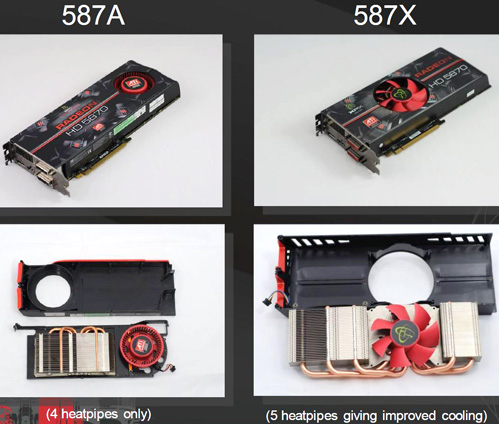
HD 5870 is a part of AMD’s Evergreen graphics card family, and the card is not only fast and powerful, but comes with a plethora of features such as DirectX 11 hardware tessellation support, shader 5.0 extension, multi-threading, ATI Eyefinity, DirectCompute, OpenCL, stream computing, HDMI 1.3a (DTS Master Audio/Dolby True-HD).
The card’s ticker is the powerful Cypress XT GPU. Compared to AMD’s previous generation, the transistor count doubled from 959 milion on the HD 4890 to 2.15 billion on the HD 5870. The same happened to stream processors who got a boost from 800 on the HD 4890 to 1600 on the HD 5870. The rest of the specs list 32 ROPs, 80 texture units and 1024MB of GDDR5 memory running on a 256-bit memory interface.
Unfortunately, all this wasn’t enough to stop Nvidia’s new DirectX 11 chip – Fermi GF100. Nvidia’s ace packs more than 3 billion transistors, so the GTX 480 now stands as the champ of single-GPU cards. Although the GTX 480 is faster in games, the HD 5870 isn’t to be underestimated and does in fact beat its competitor in certain aspects, such as capability to run more than two monitors on a single card.
Before we move onto details, we must add that our today’s card comes with a free Aliens vs. Predator game coupon, and you can pick your free game up via Steam. This offer extends to chosen XFX cards, among which is our today’s HD 5870 900M 1GB DDR5 DP HDMI DUAL DVI PCI-E Black Edition (Model No.: HD-587X-ZN, Part No.: HD-587X-ZNBV).
It’s well worth noting that XFX always has something in store for its Black Edition customers and those users enjoy additional benefits such as Priority Technical Support, invitations to members-only events, members-only product offers, exclusive info and competitions, etc. This, coupled with the fact that Black Edition cards are made from only the crème of the crop GPUs and other components, makes this card one of firm HD 5870 favorites.
The packaging is similar to the rest of XFX’s HD 5800 offer – small and sturdy. The box features an almost invisible Black Edition sign, which clearly show that the package holds one mean gaming machine.
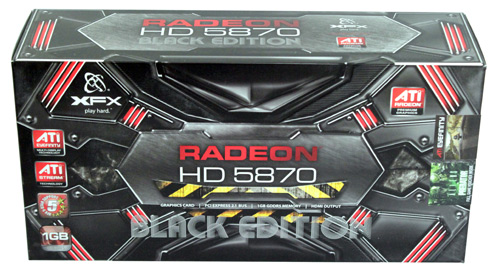
You’ll notice a small Aliens vs Predator picture on the front, meaning that XFX has got you covered for instant out-of-the-box gaming.
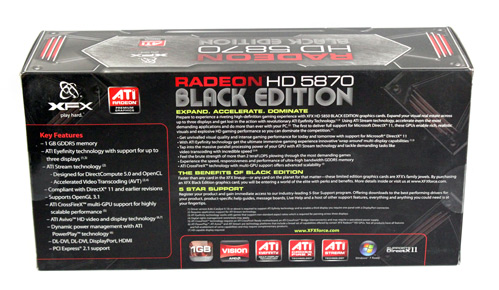
The back of the box shows XFX HD 5870 Black Edition basic features and lists other specs such as 1GB of GDDR5, HDMI and DisplayPort outs, ATI Eyefinity multi-monitor support, DirectX 11, ATI Stream technology, PCI Express 2.0, CrossfireX support, etc.
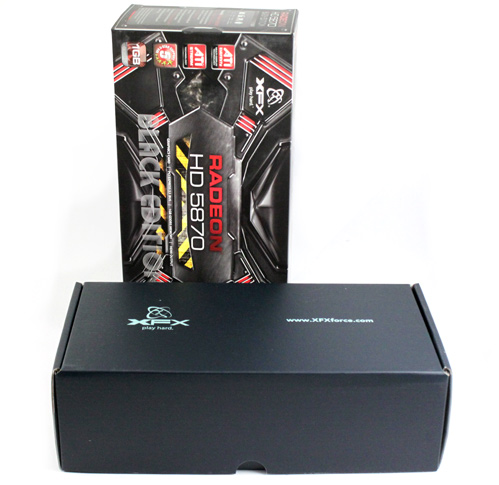
HD 5870 Black Edition comes in sturdy dual packaging. The smaller top package holds Aliens vs Predator game, driver CD, installation guide, quick installation guide, DVI-to-VGA adapter, 2x molex-to-6-pin cable adapter and a CrossFire bridge, XFX's "Don't Disturb I'm Gaming" door sign, a neat XFX Black Edition metal badge and a bunch of XFX stickers. You can see what the package contains in the following pictures.

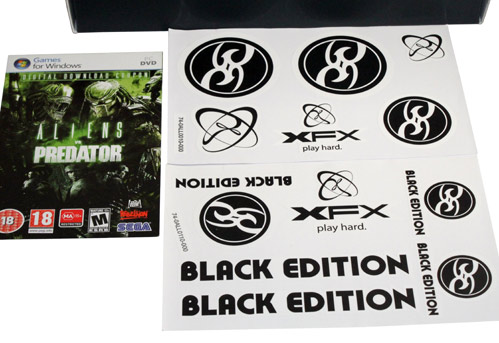
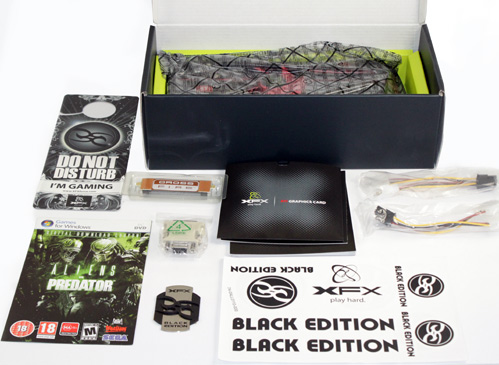
XFX HD 5870 Black Edition comes with non-reference cooling, which compared to the reference one has much larger dissipation surface. This results in almost inaudible 2D operation and acceptable 3D noise levels. This means that you’ll indeed hear the fan while gaming, but not nearly enough to bother you. GPU temperatures are about 10°C lower than on the reference card, which means that you can manually lower the RPM and further silence the GPU even when under workload.

XFX cut the PCB short from reference 28cm to 25.7cm, meaning there are changes afoot.
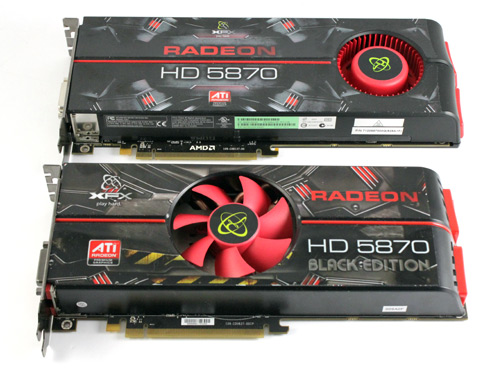
Bad thing about the positioning of the HD 5870 Black Edition’s fan is that part of the heat is dissipated within the case, so you might want to make sure of adequate in-case airflow. On the other hand, tha fan operates directly above the GPU and blows air to both sides of the heatsink equally. You’ll find more carved out air outlets than on the reference card, and you can catch a glimpse of the heatpipes through them.
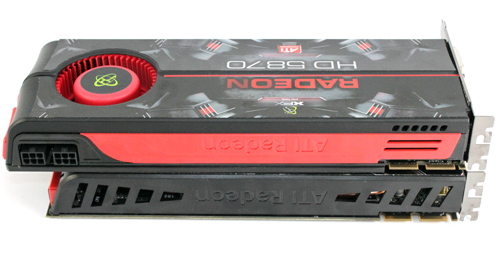
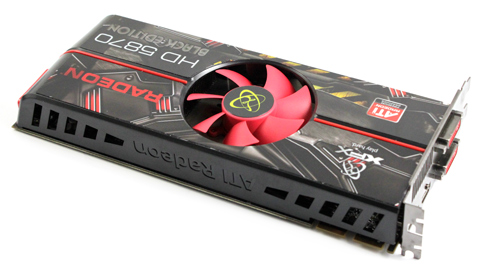
Black Edition’s power connectors are not placed on top, but rather at the end of the card. Although the card is shorter than the reference one, smaller computer cases might make reaching power connectors difficult.
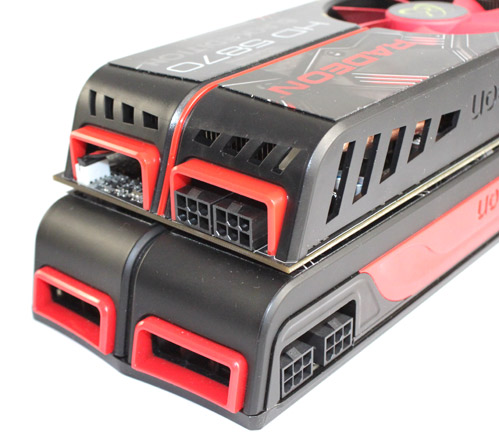
XFX HD 5870 Black Edition comes with identical set of outs as the reference card – two dual-link DVI outs, HDMI and DisplayPort.
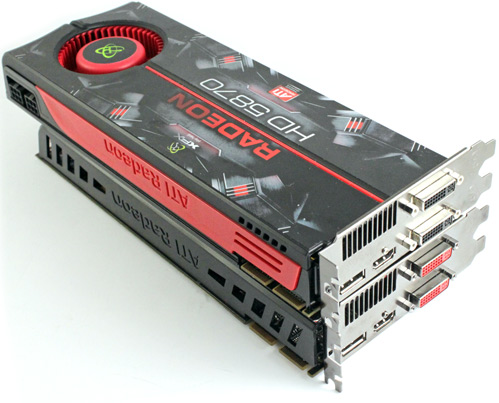
Thanks to the advanced display output, the card has six TMDS signals at its disposal. The signals can be combined in various ways, with one dual-link DVI out requiring two TDMS lines. HD 5870 cards allow for simultaneous use of three video outs, as long as one of the outs is the DisplayPort. Otherwise, you’re limited to two monitors (two DVI outs or DVI-HDMI combination).
ATI Eyefinity allows for combining output signals so that a large resolution picture can be displayed across three monitors. You can use bezel correction, which removes the parts of the picture hidden by the monitor bezels. When more monitors are stacked next to each other, the part of the picture behind the bezels will not be shifted to the next monitor, but rather stay hidden which can be useful in gaming but not office work.

XFX HD 5870 Black Edition really struck our chord the first time we used it – the card is really quiet. After a conversation with XFX, it turned out that we got a test-sample with a beta version of BIOS, which made the fan spin at 55% RPM in idle mode. The new BIOS we got, and which will end up in retail, lowers the fan RPM to 30% RPM and in turn makes the card almost inaudible. XFX used NTK(HK) Limited 8cm 2-ball fan (rated at 0.48 A) whose maximum RPM count was about 4170 RPM.
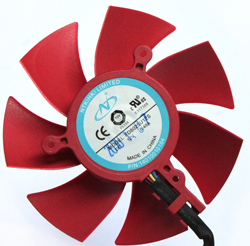
HD 5870 Black Edition’s PCB is pretty similar to the Club3D’s version for the HD 5870 Overclocked edition, which we’ve tested here. Still, the cooling is pretty different.
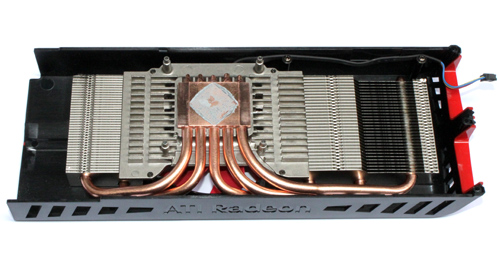

Instead of Club3D’s 4-heatpipes method, XFX chose to use 5-heatpipes, as you can see from the picture below. The fan is a part of XFX’s cooling, rather than a part of the plastic hood, which is the case with Club3D’s card. As long as we have our peace, we don’t really care about the differences.

GPU phase regulation is 4-phase with Renesas R2J20602 power pack. Unfortunately, the card doesn’t come with Volterra VT1165 MF voltage regulator, which is featured on the reference card and allow for software changes of voltage. Instead, XFX opted on uPI uP6213 which don’t offer these capabilities. The controller is on the back of the PCB.

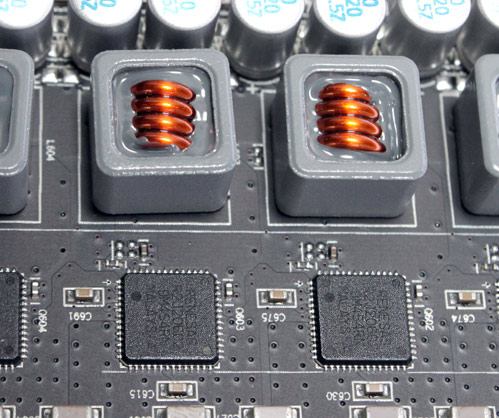
Using DrMos does have advantages over the classic MOSFET - loading is more than 1.5x better, performance improved 25%, low operation temperature, Longer life span. On this card, Dr. Mos has a large average output current (max 40 A), small package: QFN56 (8 mm x 8 mm x 0.95 mm), and maximum operating temperature of up to 150°C.
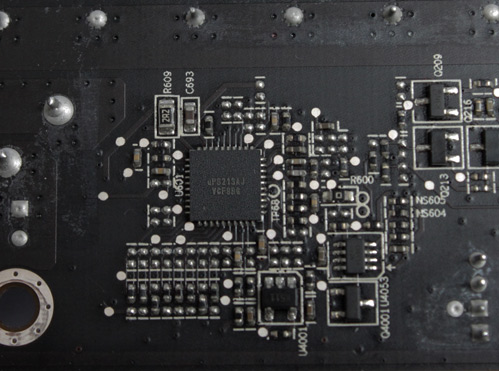
The card comes with Samsung K4G10325FE-HC04 chips rated at 1250 (5000) MHz, and XFX runs the memory at exactly those speeds. The reference card’s memory runs at 1200 (4800) MHz. Note that the heatsink doesn’t touch the memory.
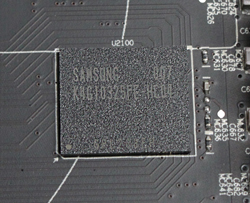
Testbed:
Motherboard: EVGA 3xSLI
CPU: Core i7 965 XE (3.6 GHz / 1.270 Volts, Intel EIST and Vdrop enabled)
Memory: 6GB Corsair Dominator 12800 7-7-7-24
Power Supply: CoolerMaster Ultimate 1100W
Case: Corsair Obsidian 800D
Fan Controler: Kaze Master Pro 5.25"
Operating System: Win7 64-bit
197.41 WHQL
CCC 10.4
Futeremark Vantage
GTX 480 is currently the fastest single-GPU card, but XFX came very close with its HD 5870 Black Edition and even won by 2.7% in the most demanding, Vantage Extreme test.
The GTX 480’s advantage over the reference HD 5870, however, melts from 10.5% in Performance to 6.2% in High and ends up at about 3% in Vantage Extreme.
In Vantage tests, the GTX 480 constantly beats the GTX 470. Performance test reports 24.7% better results, High settings report 26.6%, whereas Extreme settings result in a 27.2% advantage, naturally in favor of the GTX 480.
Comparing the GTX 470 to the reference HD 5870 shows that the latter card packs more punch in more demanding tests. The GTX 470 ends up 12.7% slower in Vantage Performance, 19.3% at High settings and 23.4% at Extreme settings.
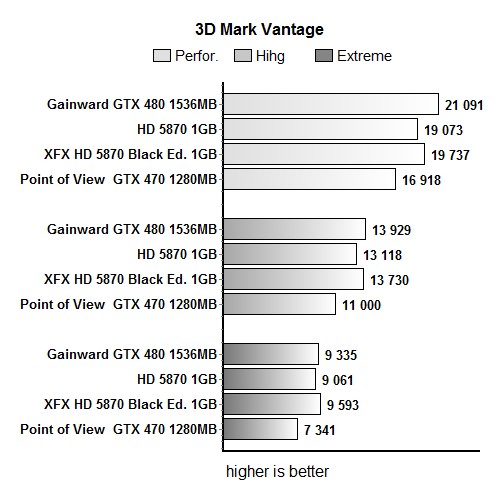
Far Cry 2
In FarCry 2, Nvidia’s high-end GTX 400 series comes out on top and it’s even more evident when 8x antialiasing is turned on. FarCry 2 results prove that by redesigning ROP subsystems in the GT100 chip, the company managed to improve compression and rendering efficiency as well as rendering smaller primitives that can’t be compressed. Throughput was also much improved compared to GT200 architecture, which resulted in overall better antialiasing performance and significantly smaller drops in performance when switching from 4xAA to 8xAA.
Radeon HD 5870 ends up about 50% slower than the GTX 480 in both tested resolutions with 8xAA. The difference ducks to 39% at 1920x1200 and 4xAA and to 33.6% at 2560x1600, which proves that Nvidia’s GF100 is more efficient with 8xAA. With antialiasing turned off at 2560x1600, the performance difference ends up at only 15.5%.
Point of View’s GTX 470 outpaces the HD 5870 in a few scenarios, and the highest gap Nvidia’s ace made was at 1920x1200 and 8xAA – 17%. By increasing resolution and turning on antialiasing, the GTX 470 loses the fight versus the HD 5870.
XFX HD 5870 Black Edition scores up to 5.9% better than the reference HD 5870 card in FarCry 2.
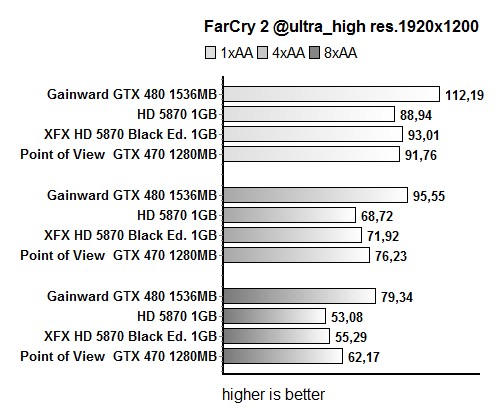

Crysis
XFX managed to score the highest result in Crysis. We see that XFX manages to make the highest performance gap at 2560x1600 and no AA – at that resolution it manages to beat the GTX 480 by 8.7%.
GTX 470 did manage to beat the HD 5870 by up to 17% in FarCry 2, but Crysis is another story. In this game, the HD 5870 beats the GTX 470 by 22-29%. Since the GTX 470 is slower than the GTX 480, and Crysis rates both GTX 480 and HD 5870 almost identically, it was clear that GTX 470 won’t come out on top.

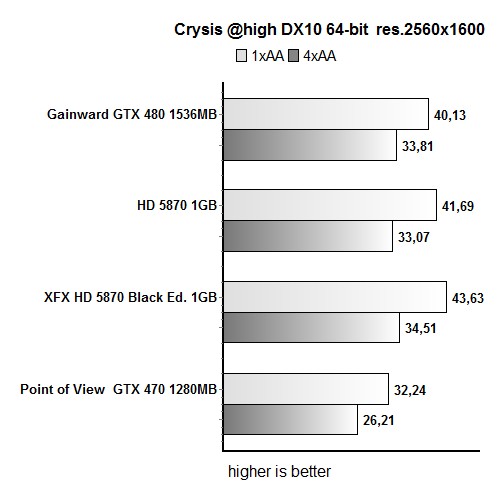
Batman Arkham Asylum
Batman Arkham Asylum is one of the games that features PhysX effects, but if you’re playing it on one of the Radeon cards, you’ll have to turn them off.
Another important thing to note is that switching from 1xAA to 4xAA causes a higher performance hit on the HD 5870 than on the GTX 400 cards. The right answer to the question of “why is that?” has not yet been found, but has turned into a rather hot discussion subject.
“Quote from AMD: In this game, Nvidia has an in-game option for AA, whereas, gamers using ATI Graphics Cards are required to force AA on in the Catalyst Control Center. The advantage of in-game AA is that the engine can run AA selectively on scenes whereas Forced AA in CCC is required to use brute force to apply AA on every scene and object, requiring much more work.”
“Quote from Nvidia: “We are proud of the work we do in The Way It's Meant to be Played. We work hard to deliver kickass, game-changing features in PC games like PhysX, AA, and 3D Vision for games like Batman. If AMD wants to deliver innovation for PC games then we encourage them to roll up their sleeves and do the same. NVIDIA Developer Relations”
Batman results show that AMD doesn’t quite fare great with antialiasing, but it gets better without it.
At 1920x1200 and no antialiasing, the difference is only 4.7%, but the GTX 480 makes it much higher after we turned 4xAA on – it beats the HD 5870 by as much as 45.9%. The difference at 2560x1600 with no antialiasing is once again minimal; only 2.8%. However, after turning on 4xAA, the gap extends to 50%.
At 2560x1600 in Batman Arkham Asylum sees the HD 5870 perform as much as 82.8% slower after applying 4xAA, while the GTX 480 performance drops by 25.3%. The same scenario results in the GTX 470 running 27.5% slower, which is similar to the GTX 480.
Turning on 4xAA antialiasing at 1920x1200 results in the GTX 480 performing 23.1% slower. Performance drops by 26.3% when you turn on the 4xAA antialiasing at 1920x1200 resolution with the GTX 470. On the other hand, the performance of the HD 5870 drops by as much as 71.4% with same settings. These results clearly show that antialiasing causes higher drops in performance on AMD HD 5870 card.
Not much to complain about Radeon HD 5870’s performance in Batman as it scores almost 60fps at 2560x1600 and 4xAA. It’s a pity that PhysX is intended only for Geforce cards.
The GTX 470 ends up slower than the HD 5870 at resolutions with no antialiasing by 16.6% and 20.5%, respectively. Upon turning on 4xAA on, the situation changes in the GTX 470’s favor. It manages a nice comeback and beats the HD 5870 by 16.3% at 1920x1200 and 19% at 2560x1600.
XFX HD 5870 Black Edition once again shows its real power at 2560x1600 and no AA.
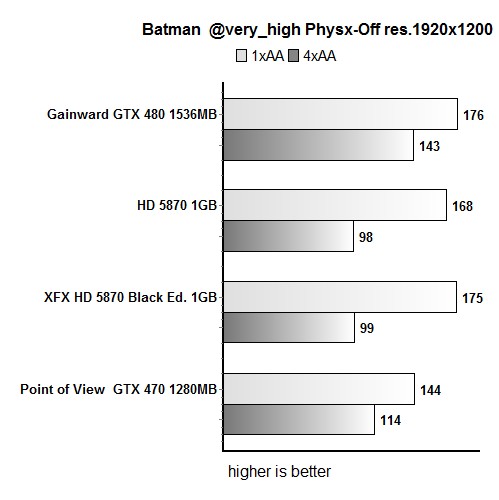
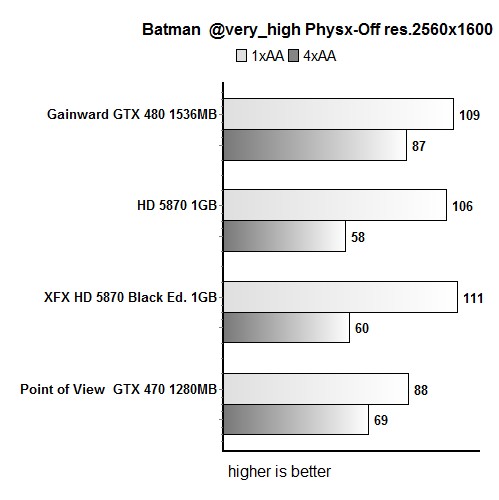
At 1920x1200, the GTX 480’s PhysX capabilities are 26.6% better than the GTX 470’s. At 2560x1600, the GTX 480 outruns it’s little brother by 22.7%.
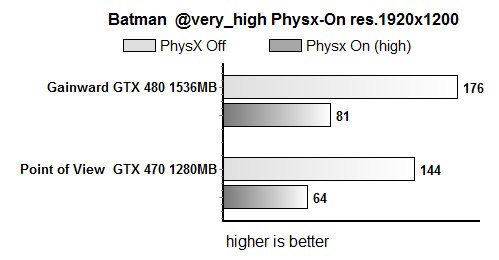
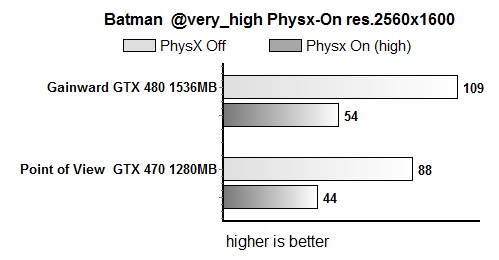
HAWX
You might’ve noticed that playing FarCry2, Batman and Crysis at the highest tested resolution, 2560x1600 (and no AA), results in minimum difference between the HD 5870 and GTX 480, while XFX’s Black Edition ends up as the fastest several times. Gaming with antialiasing isn’t working in HD 5870’s favor as it ends up as much as 50% slower in FarCry2 and Batman. Crysis reported pretty even performance while HAWX manages to put a better face on the Radeon HD 5870.
At 1920x1200 and no AA, Gainward GTX 480 outscores the HD 5870 by 16.7% while turning on 4xAA results in 20.9% advantage. At 2560x1600, Gainward GTX 480 outruns the reference HD 5870 by 4% (no AA) and 12% (4xAA). These results show that antialiasing takes a higher performance toll on HD 5870s than on GTX 480 cards.
After turning on 4xAA at 1920x1200, we noticed that the GTX 480 performs 14.5% slower, whereas the HD 5870 takes an 18.7% hit. Increasing the resolution to 2560x1600 also takes its toll so turning on 4xAA on the GTX 480 results in 17.6% slower GTX 480 and 25.8% slower HD 5870 performance. Just for comparison, turning on antialiasing in FarCry2 at 2560x1600 results in the HD 5870 performing 38.4% slower performance. GTX 480’s performance toll is much lower in FarCry 2 – 19.7%.
The GTX 470 couldn’t defeat the HD 5870 as the latter card handles antialiasing much better than in FarCry2 and Batman. Both aforementioned games tend to prefer the GTX 470 when it comes to antialiasing. In HAWX, the GTX 470 lags behind the HD 5870 by 5.9% and 16.9% at 1900x1200 and 2560x1600, respectively. After turning antialiasing on, the differences duck to 3.4% and 11.9% respectively.
XFX HD 5870 Black Edition outpaces the reference card by about 4.3%.
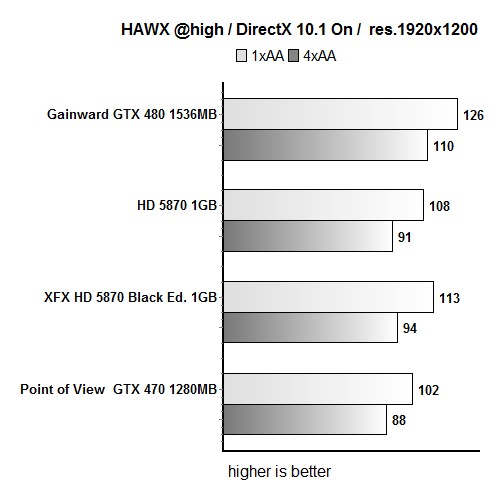
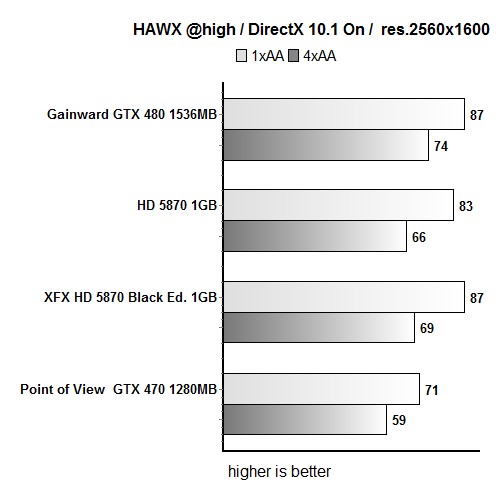
Dirt 2
Dirt 2 is one of the newer games that utilize certain parts of DirectX 11. At 1920x1200, the GTX 480 beats the HD 5870 by about 20%. This difference melts to about 7% at 2560x1600, with and without AA.
XFX HD 5870 Black Edition almost catches up with the GTX 480 at 2560x1600, and the difference amounts to only 1-2fps or 3.5%. The reference HD 5870 ends up slower than the Black Edition by at most 4.9%.
Point of View GTX 470 fares well versus the HD 5870 at 1920x1200, but as soon as we hit 2560x1600, the HD 5870 proves that it’s faster. At 1920x1200 and 2560x1600 (no AA), the GTX 470 is slower by 1.6% and 15.9%, respectively. After turning antialiasing on, the difference melts to 3.4% and 16.7%, respectively.
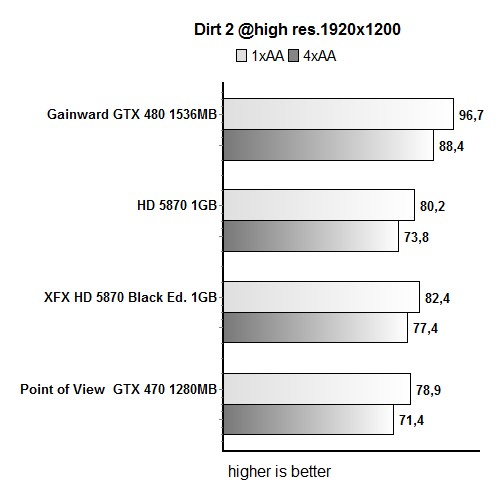
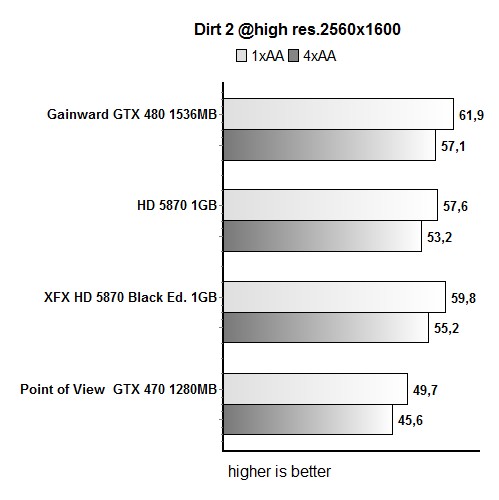
Metro 2033
Metro 2033 is post-apocalyptic game developed by 4A Game and implements a number of advanced DX11 features with the latest generation of DX11 graphics cards. GTX 480 takes the cake in this test, but the differences aren’t very high. At 1680x1050 and 1920x1200, the GTX 480 beats the HD 5870 and GTX 470 by about 18% and 28%, respectively.
At 1920x1200 in Metro 2033, XFX’s HD 5870 Black Edition card ends up faster than the reference HD 5870 by 2.6%, and by 4.7% at 2560x1600.

Unigine: Heaven
In tessellation tests, XFX’s Black Edition once again outruns the reference HD 5870 by up to 5%.
Nvidia made the GTX 480 with serious tessellation potential in mind, and the results confirm that. The level of tessellation can be regulated in Heaven engine and we see that the difference between the GTX 480 and HD 5870 rises after setting the tessellation level at Extreme. It’s well worth noting that Gainward GTX 480 manages a playable framerate at 1920x1200 with maximum tessellation.
At Extreme tessellation settings, Point of View’s GTX 470 outpaces the HD 5870 by about 27%. The GTX 470 scores 710 on the test while the HD 5870 scores 557.
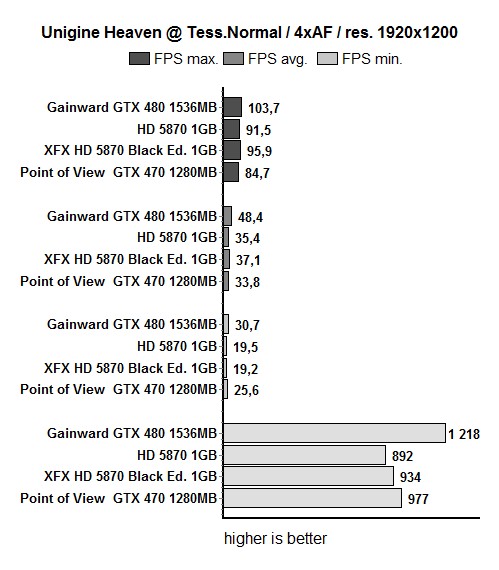
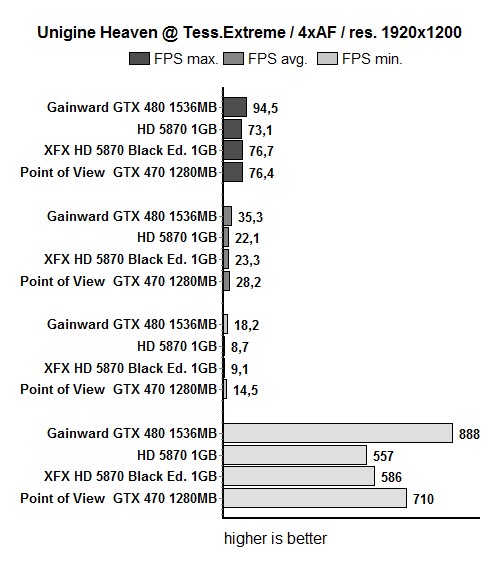
Overclocking
XFX’s HD 5870 Black Edition card is pre-overclocked from reference 850MHz to 900MHz, giving the Black Edition card up to 5% better performance compared to the reference card. The card’s memory ticks at 1250MHz (5000MHz) while the reference clocks are at 1200MHz (4800MHz). ATI Overdrive in the the current, 10.4 version does not support GPU overclocking on the Black Edition card. In order to go beyond, we used AMD’s GPU ClockTool v0.9.26. tool.
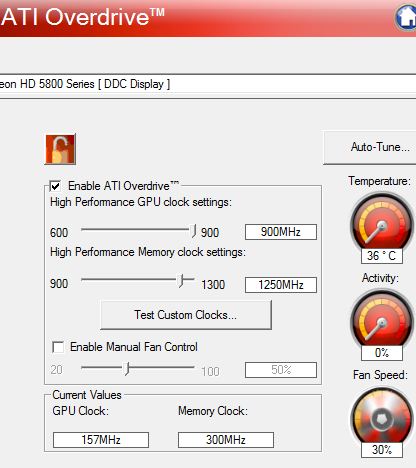
As far as overclocking the memory, we didn’t have much luck with Samsung’s memory – the maximum clocks we managed were 1259MHz (5036MHz). We easily overclocked the GPU by 46MHz more, without meddling with voltage. Note however that we couldn’t meddle with voltages anyways, because the card uses a uPI uP6213 voltage regulator which doesn’t support for changing voltages in software.
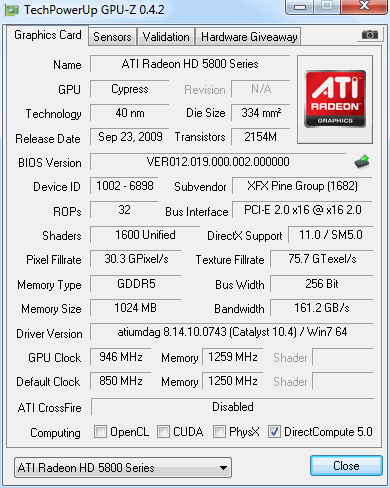
Power consumption is almost the same as on the reference card, although Black Edition runs at higher operating clocks.

The fan is very quiet in idle mode and spins at about 30% RPM (~ 1230 RPM). Maximum fan speed at 100% RPM results in 4227 RPM. In dynamic mode, fan speed reached about 2720, which is audible but not enough to annoy you.
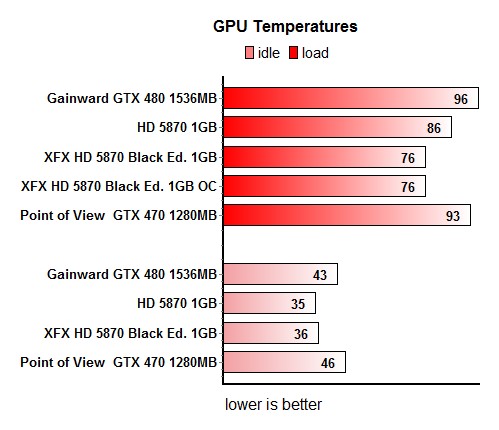
The fan gets a bit irritating as it doesn’t allow for temperatures exceeding 76°C. As soon as the GPU hits anywhere near 76°C, the fan speeds up (up to ~2720RPM) in order to lower temperatures. Afterwards, it gets quieter for a while and then does the entire routine again, depending on the GPU usage.
We solved the varying speed/noise problem by setting the fan at constant 50% RPM (~2260RPM), so that the fan doesn’t get loud during gaming. At the same time, the temperatures lingered around 87°C, which is the same operating temperature we see on reference cards.
Conclusion
Today we had a chance to test another non-reference HD 5870 card. Our today’s guest was XFX’s HD 5870 Black Edition and the name suggests that this is no ordinary card. In fact, apart from higher clocks and in turn better performance, Black Edition cards bring some exclusive benefits to its owner – Priority Technical support, dibs on exclusive products, etc. The card comes with non-reference cooling, meaning XFX really went out of their way to deliver a quality product which can compete in style.
The first thing we thought about upon seeing the card was whether it was quiet. Indeed, the cooling turned out to be much more efficient as well as quieter than the reference solution. You probably know that the reference solution is quiet in idle mode, but while the HD 5870 Black Edition’s cooling isn’t inaudible when the GPU is under load, it sure is much quieter than the reference solution. Thanks to XFX’s efforts, the cooling is more efficient than the reference so you can manually make the fan quiet and retain silence even in 3D mode. Naturally, this will sacrifice some cooling efficiency, but know that you’ll manage to keep decent noise levels while keeping temperatures lower than on the reference card.
Black Edition cards run stable at higher operating clocks than reference, and you’ve seen that it does that all the while staying cooler and quieter than the reference card. The GPU runs at 900MHz, which is 50MHz higher than reference whereas the memory was pushed from the reference 4800MHz to 5000MHz.
Although Nvidia GTX 480 has taken the performance cake, the difference isn’t that drastic and HD 5870 owners will have nothing to complain about when it comes to gaming. Compared to the reference HD 5870, the Black Edition many times ran up to 5% faster, and even managed to beat the GTX 480 in some of the tests. Furthermore, if you’re looking for a card that will allow for three monitors on one graphics card, ATI’s Eyefinity is the graphics you’re looking for.
Black Edition will set you back some €50 more than the reference card, but there are some few pros to this card – it runs silent, comes with a free Aliens vs. Predator game, etc. If, however, silence is not something that plays a key factor when purchasing a graphics card, you can check out the rest of XFX’s offer, here, which surely packs something both for your taste and your wallet.
